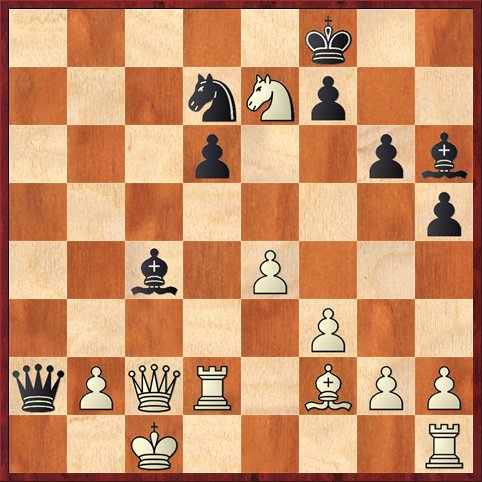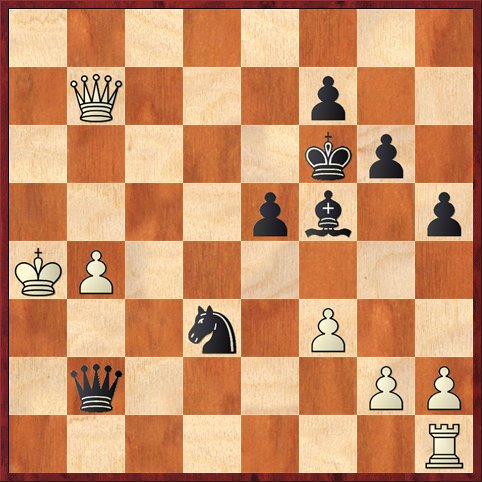Last week Gjon Feinstein asked me, “Can we go over a couple of my games on your computer?” This request was a surprise to me. He is a chess teacher, so he knows full well that computer analysis can be fool’s gold. I don’t think he even owns a computer chess program.
Nevertheless, I think his curiosity got the best of him. The games in question were two of the absolute highlights of his chess career. In one of them, Rybka uncovered some spectacular tactics that change or at least clarify the evaluation of the position.
The year: 1989. The tournament: the American Open. Gjon’s opponent: International Master Jack Peters.
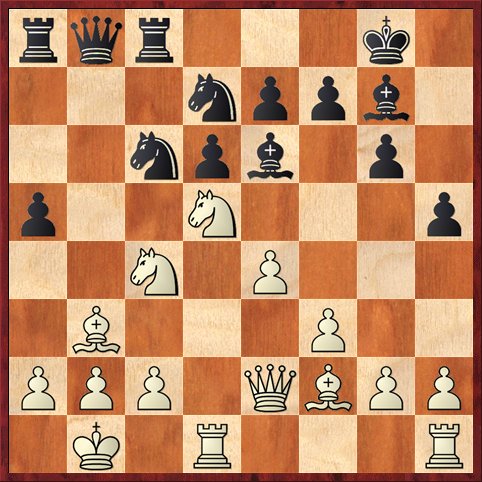 Position after 19. … a5. White to move.
Position after 19. … a5. White to move.
FEN: rqr3k1/3nppb1/2npb1p1/p2N3p/2N1P3/1B3P2/PPP1QBPP/1K1R3R w – – 0 20
Playing Black in a Dragon Sicilian, Gjon has sacrificed his b-pawn to speed up his attack on White’s king. Quite unusually for a Dragon, White doesn’t really have any serious threats on the kingside yet, so it just comes down to whether White can stop Gjon’s attack. Certainly White has enough pieces on the queenside, and they aren’t just tied down to defense, either — they’re pretty mobile.
So perhaps it’s not surprising that Rybka evaluates the position at +0.5 for White. However, as Gjon joked, “That means it likes my position!” In other words, Black has half a pawn of counterplay for his pawn. When a computer says that, it’s pretty serious — that often means a full pawn of counterplay against a human opponent.
In the diagrammed position, Black has a serious threat: 20. … a4. What White should do about it? Like most strong players, Peters prefers active defense to passive defense, and so he just can’t resist placing a knight on that beautiful, enticing square b6.
20. Ncb6?
Gjon was never entirely sure whether this was a blunder or not, but thanks to the computer we can say definitely that it is. Rybka’s top recommendation is 20. Ba4!, a sensible move whose point is to stop the march of the a-pawn. I could give oodles of computer analysis, but that would take us too far afield and I’d rather leave it as a project for the reader. The short summary is that White focuses more on closing the lines to his king and less on winning material.
However, Peters does what all human chess players tend to do: take the material and run.
20. … a4! 21. Nxc8 ab 22. Nxe7+ Nxe7 23. Nxe7 Kf8 24. cb.
By the way, 24. ab would not have made much difference.
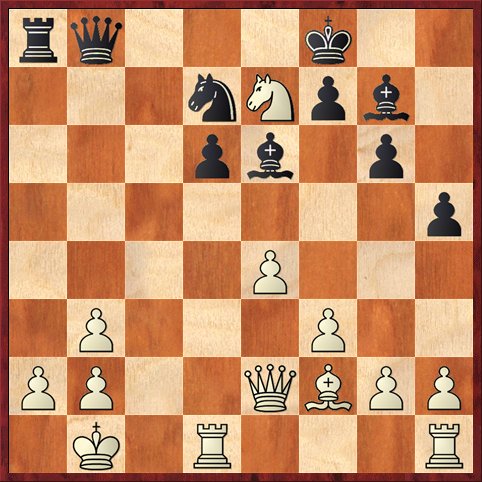 Position after 24. cb. Black to move.
Position after 24. cb. Black to move.
FEN: rq3k2/3nNpb1/3pb1p1/7p/4P3/1P3P2/PP2QBPP/1K1R3R b – – 0 24
This is the position I really wanted to share today. I could be melodramatic about it and say: Black to play and win.
Here Gjon played the automatic recapture, 24. … Kxe7? During the game and for all the 25 years since then, he never even suspected that Black had anything better. Do you see the surprise that Rybka uncorked on us?
A little more space, if you want to think about it…
Okay, time’s up. The move that Rybka found was 24. … Rxa2!! This is the sort of move that someone like Alekhine would find, but the rest of us are too caught up in our mental straightjackets to even consider. How many of us would give up a rook instead of taking a free knight? Honestly?
I think the psychological power of a move like 24. … Rxa2 would probably cause an opponent to crumble right away. But is the sac actually sound? You could spend hours analyzing this position, and I strongly recommend that you do. However, because this post is about computer analysis, I will just give you Rybka’s best play for both sides:
(A) 25. Kxa2 Qxb3 26. Kb1 Qa2+ (full credit also for 26. … Bc4) 27. Kc1 Bc4! It’s very important to close the mating net instead of continuing to chase White’s king with 27. … Qa1+? This is something I have learned from lots of games with the computer. 28. Qc2 (with the idea of interposing on b1) Bh6+! (continuing to weave the mating net) 29. Rd2 (diagram)
Position after 29. Rd2 (analysis). Black to move.
FEN: 5k2/3nNp2/3p2pb/7p/2b1P3/5P2/qPQR1BPP/2K4R b – – 0 29
Okay, you get another chance at Alekhine-style chess. Black to play and win.
The answer is 29. … Ne5!! An amazing position. Black has just a bishop for two rooks. He could grab the knight with 29. … Kxe7. He could grab the exchange with 29. … Bxd2+. He could even grab a whole rook with 29. … Qa1+ 30. Qb1 Qxb1+ 31. Kxb1 Bxd2. But instead, he goes for the jugular. After 29. … Ne5 there is basically nothing White can do to stop 30. … Ne3+ followed by 31. … Bb3, winning a queen and probably more.
But we’re not done yet! Let’s go back to the second diagram and ask what would happen if White declined the rook sacrifice.
(B) 25. Nd5!? Here, of course, the tempting thing for Black to do is win White’s queen with 25. … Rxb2+. However, after 26. Qxb2 Bxb2 27. Kxb2 White has two rooks and a pawn for the queen and, in my opinion, excellent chances of holding the game because the pieces are active and there are not too many pawn weaknesses. Instead Black should keep attacking with 25. … Qxb3! Now Rybka’s “best-play-for-both-sides” variation goes 26. Bd4 Bxd5 27. Bxg7+ Kxg7 28. ed (28. Rxd5 is no better). That brings us to the diagrammed position.
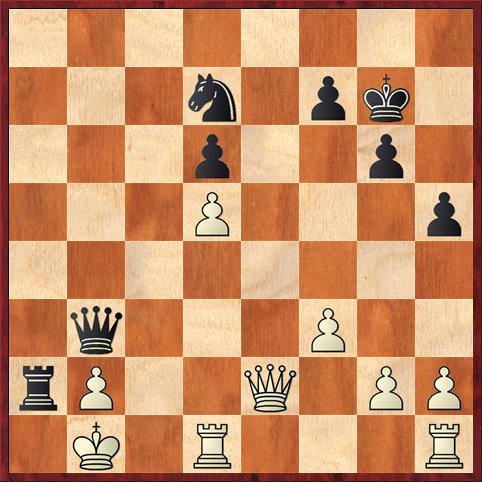 Position after 28. ed (analysis). Black to move.
Position after 28. ed (analysis). Black to move.
FEN: 8/3n1pk1/3p2p1/3P3p/8/1q3P2/rP2Q1PP/1K1R3R b – – 0 28
Again it’s Black to play and win. This one is a little bit simpler.
28. … Qa4! (threatening mate) 29. Kc1 (forced) Nc5! Just as in the previous variation, it’s the knight that comes up at the end and strikes the winning blow. It’s kind of hard to believe that White, in spite of his extra exchange and pawn, can do nothing, but 30. Kd2 runs into 30. … Rxb2+ and after anything else, 30. … Nb3+ is death.
Wow! So how, you might wonder, did the game actually end?
Way back in the second diagram, Gjon played 24. … Kxe7? And Peters immediately blundered! He should have played 25. Bg3, and after 25. … Ne5 26. Qe3 it’s a mutually hard game. White’s king is still in danger but Black has trouble getting his knight on e5 out of the bishop’s way, and the Black king is a little bit uncomfortable, too. As before, Rybka evaluates the position as +0.5 for White.
Instead Peters played 25. Bd4?, and after 25. … Bxd4 26. Rxd4 Gjon got a second chance to play his sacrifice!
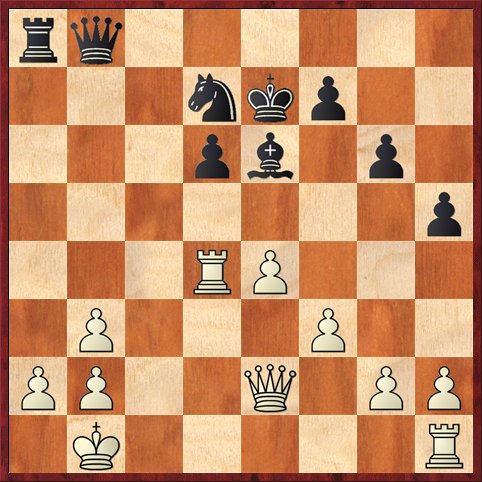 Position after 26. Rxd4.Black to play.
Position after 26. Rxd4.Black to play.
FEN: rq6/3nkp2/3pb1p1/7p/3RP3/1P3P2/PP2Q1PP/1K5R b – – 0 26
26. … Rxa2! From our point of view, the sacrifice now is more prosaic than it would have been two moves earlier. But of course from Gjon’s point of view during the game, playing against an International Master, it was a tremendous shot to find. Black now stands much better. The game ended:
27. Kxa2 Qa7+ 28. Kb1 (A cute twist: 28. Ra4 fails because of 28. … Qxa4+! The b-pawn is pinned.)
28. … Qxd4 29. Qb5? (way too optimistic) Nc5 30. b4 Nd3. Even in pre-Rybka days, Gjon figured out that 30. … Bc4! would have been more deadly. But the text move is good, too.
31. Qb7+ Kf6 32. e5+ de 33. Kc2 Bf5 34. Kb3 Qxb2+ 35. Ka4 Black loses on time.
FEN: 8/1Q3p2/5kp1/4pb1p/KP6/3n1P2/1q4PP/7R b – – 0 35
If this were Chess Base, the PGN would simply say “1-0“. You would say, “What?? Doesn’t 35. … Nc5+ just win the queen?”
Yes it does, but unfortunately Gjon’s flag fell before he could play that move. The loss on time spoiled what could have been one of his greatest masterpieces. Of course, all of the last few moves were played in intense time pressure. The time control was at move 40.
I’ve lost games on time, too — probably every tournament player does, sooner or later — but I don’t think I have ever forfeited in such a dead-won position. It’s too bad that Gjon’s masterpiece had to be spoiled in such a way. However, it is still a great game, and thanks to Rybka’s analysis we now know that it could have been greater still!
